As we enter into March Madness, the time of the year where transport use is the highest levels of public transport usage, it’s time to look back at how PT and cycling performed in January.
Public Transport
January is always a tricky month for public transport usage with factors such as summer/school holidays and rail network shutdowns see fewer people catching buses and trains – although it is usually one of the busiest months of the year for ferry trips. By comparison March is usually the busiest month hence the term March Madness.
Despite all of this, AT’s latest public transport numbers show strong growth in January, even passing a few milestones during the month:
- This January saw more than 7 million trips within the month for the first time. To put what that means in perspective, that’s the kind of level of usage we were seeing during ‘March Madness’ just 6 years ago. So, we’re now doing in our quiet months what we did in our busiest month just a few years earlier.
- In as similar vein, with just under 1.5 million trips on trains in January, it tipped us past 22 million trips annually on the rail network. On the busway we also passed 8 million annual trips meaning combined, our rapid transit network is now carrying more than 30 million trips a year (about 29% of all trips, up from about 19% six years ago).
Overall there was a 4.3% growth in PT usage compared to January 2019 which is not the strongest we’ve ever had but within that we saw some good mode specific results as you can see in the graph below.
You can see the impact of that rise in the use of rapid transit in the graph below.
One question we’ll be looking to see is just how mad March will be this year. Last year saw us crack 10 million trips for the first time so me know but what do you think it will be this year. The graph below shows our monthly results with March highlighted in yellow. My guess is we could hit 10.5 million trips this March but a lot of that could be impacted if the industrial action from this morning escalates.
Cycling
Despite the near perfect cycling weather in January, cycling numbers were a little disappointing with counters recording a slight decrease of 0.6% in usage compared to January 2019. The most likely explanation for this is all the disruption going on around the city at the moment. As you can see on the graph below, it’s had a big impact on Quay St while other counters like the Karangahape Rd one are also down.
As you can also see the site with the most growth is the NW Cycleway at Kingsland recording a massive 37% increase in use during the month. The month also saw the highest single day on the cycleway with just under 2,000 trips in a day. We weren’t getting those kind of numbers till late Feb/Mar last year and I wonder if we’ve cracked a 2k day yet.
The growth on the northwestern really makes it even more imperative that Auckland Transport move forward quickly with their plans to widen that section, separating bikes from pedestrians.
Wellington
Wellington too is continuing to see some strong public transport growth with a 7% increase on January last year and growth for the last 12-months now up to 6.2%. Of note Wellington saw a 10% increase in rail usage in Jan. Bus usage is also continuing to climb and annually is now about 1 million trips higher than it was before Wellingtons new network kicked in – with the new numbers not including the airport bus which the old numbers have.
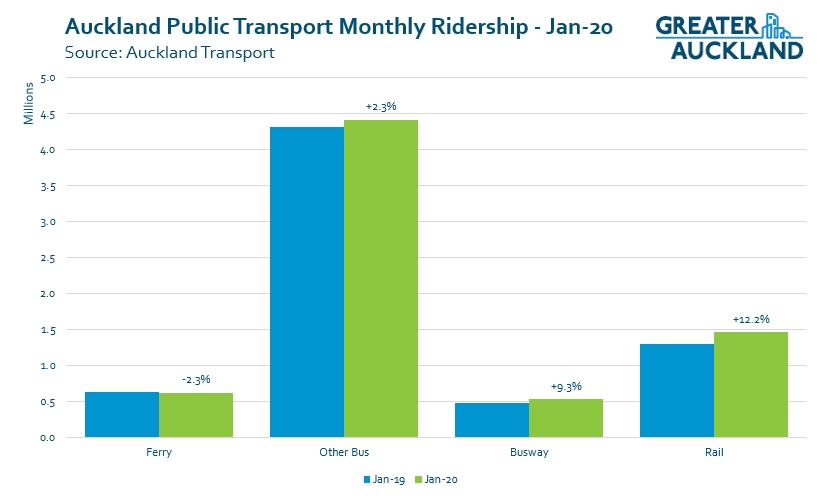
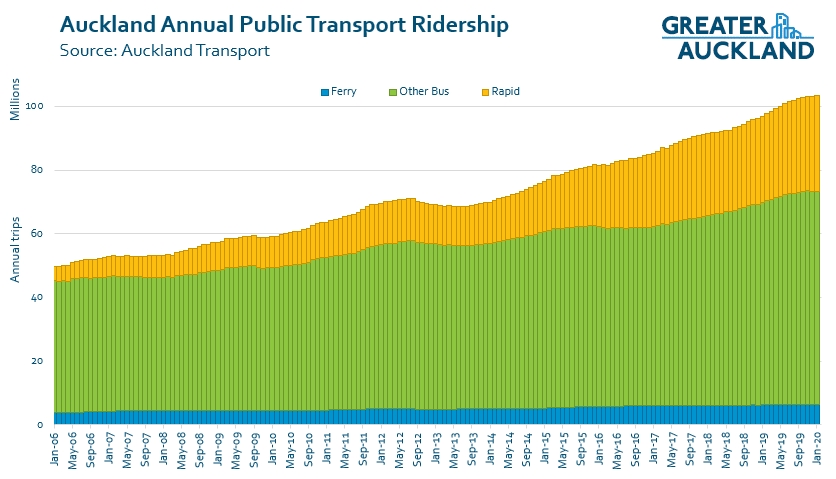
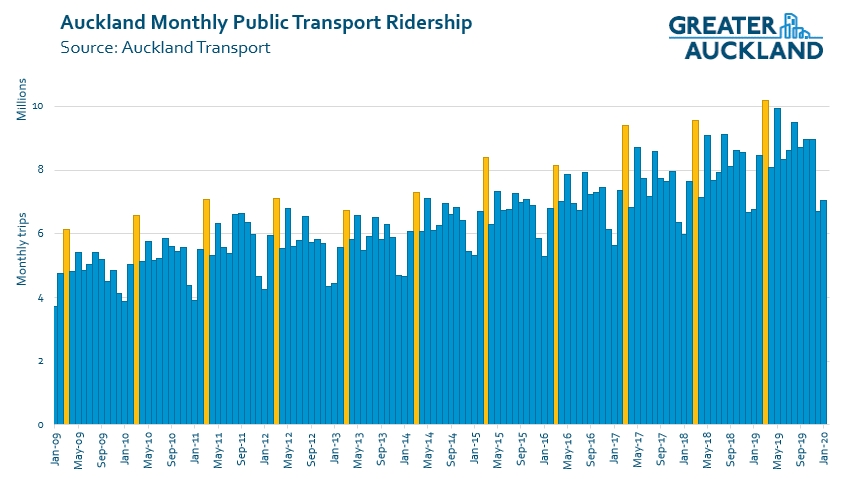
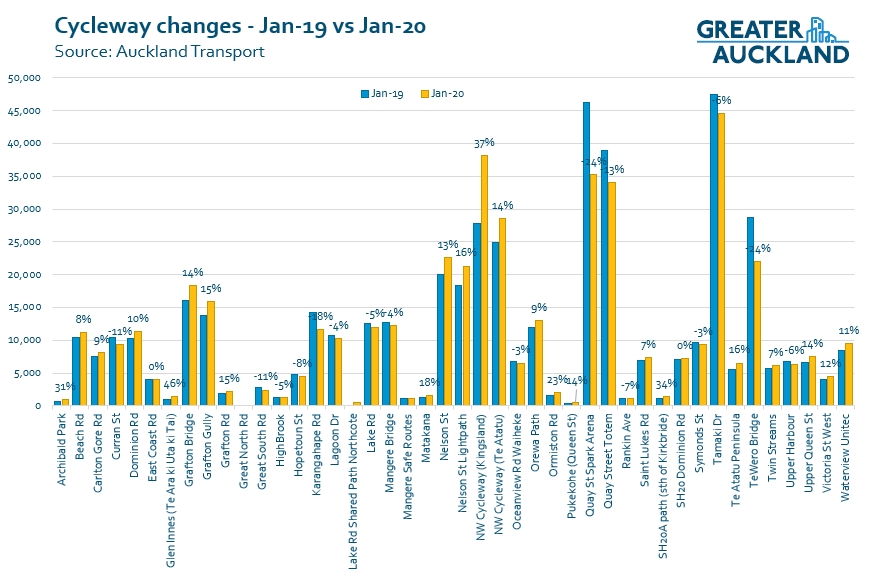
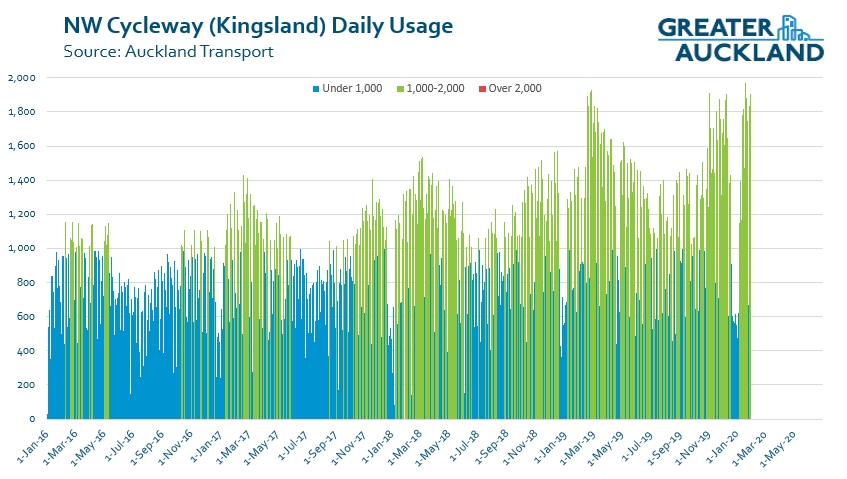

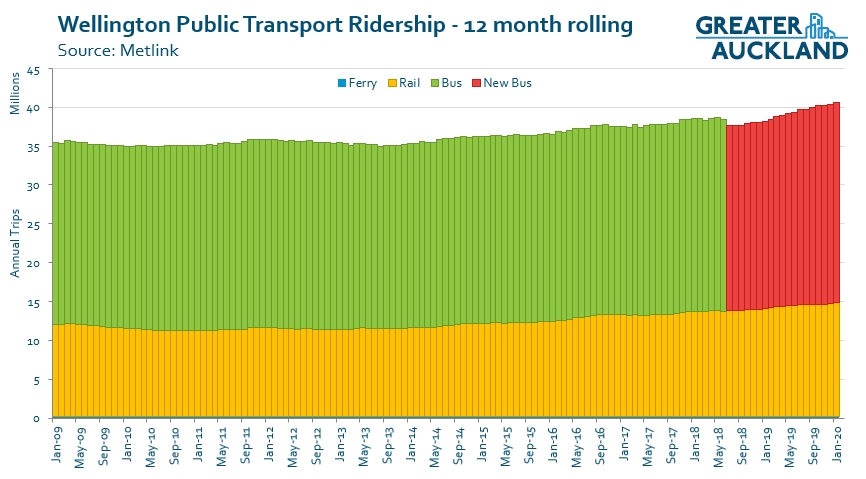

 Processing...
Processing...
Good to see the unions encouraging people to use public transport by going on strike.
Yes, it would be good if amateur drivers had the guts to do the same thing. With an average 12km commute in Auckland, most people could ride a bike. Most just choose not to, with no moral justification for doing so.
Let me see: I start early, I don’t have time at the start and end of my work day for the additional commute time cycling or PT would take and I wouldn’t project my personal circumstances or privilege over an entire population just so I can look down upon them smugly for not making what I personally perceive is the only ‘moral’ choice about how they get to work so they can make ends meet, if that?
Do you only ever make a moral choice in order to feel smug? You might be alone there, Buttwizard.
And by driving, you ARE projecting your privilege over an entire population, who will suffer the consequences. Having to get up 20 minutes earlier isn’t a moral justification for it, try again.
I love the assumption that 20 minutes is the difference between riding a bike to work and driving a car to get to work. Or that people can afford an extra 40 minutes a day of commuting. Or that people aren’t already getting up at sparrows each day to get to work and it’s just a case of good old fashioned laziness.
I would love to live in a world where that was a viable option. But I don’t and I’m not so blind to assume that everyone else just needs to harden up and has no ‘moral’ reason to drive. Not all of us can afford to live near where we work or can get work near where we live. Again, choice is privilege. Just because you can make it work doesn’t mean other people can just by ‘waking up 20 minutes earlier’.
20 mins is about the extra time on a 12km commute. By your reasoning, It’s amazing how unlucky we are that days are 24 hours long, if they were 24 hours and forty minutes bike commuting would totally be a viable option…
Your arguments that not EVERYONE can ride a bike, so you don’t have to either is pretty standard fare for passive climate change deniers. It would be great if you could offer solutions and encouragement to those who can make a difference, rather than just spurious reasons why making any effort is too hard.
When my argument is in any way motivated by or related to climate change, that will be a relevant point. Until then, it’s merely false equivalence. I could comment here on my interest in EVs as a commuter option and my genuine desire to see light rail and rapid transit rolled out en masse across the region, but you seem like someone who is pretty committed to making broad sweeping statements without any real justification, so I shan’t.
john, out of curiosity where does your bicycle commute bring you?
I’m amazed that you can do a 12km commute by car anywhere in Auckland in only 15 minutes.
Hi Roland, my commute is to Freemans Bay, from Panmure. I’m very excited about the Glen Innes to Tamaki cycle path, hopefully it’s the kind of infrastructure that pushes cycling into the “normal” realm of the public’s psyche.
Buttwizard, indeed true! Since you replied to my first post on the moral choice of cycling vs driving to mitigate climate change, answering with rapid rail or whatever else not related to climate change would certainly be a monster sidestep. I’m sorry, I really don’t understand what you’re trying to say.
That commute by car would be, um, interesting.
Nevertheless you can probably tell what is putting most people off. It is really hard to argue against the argument that “you may get killed”. I go from birkdale towards the wairau valley area which is not too long and relatively quiet. But I still spend the majority of this distance between parked and driving cars. At any of those parked cars, one mistake and you’re a goner.
Roeland… Yeah, of course. Cycling in Auckland is sometimes downright unpleasant, especially when it doesn’t feel safe. But research invariably shows that the health benefits of cycling massively outweigh the risks (admittedly it’s mostly euro research- but probably still generally true in the cycling quagmire of Auckland). With that being the case, I think it is fair to question the environmental damage caused whenever you drive, and bike whenever you can. Yes, it’s a safety risk, but it’s to the long term benefit of others. That’s the moral question, and I’m pretty certain that more than half the population could cycle commute if they took that aspect really seriously.
Sorry Roeland, correction… I’m pretty sure more than half the DRIVING population could cycle commute. I didn’t mean to include the other active/ PT commuters in that group…
My guess is that a lot of people who don’t cycle are making their choice due to the lack of safe facilities and not wanting to die.
Seems reasonable.
So you reckon if we could magic up safe cycling everywhere tomorrow, people would start biking instead of driving whenever they could? It’s a nice idea, I would hope so…
The “magic up” step is a slow step, but yes that is what has actually happened elsewhere.
Look at how many people currently take the bus. If you’re going less than, say, 7km, riding a bicycle is almost definitely faster and more reliable, and many will take this option.
When I used to ride in my youth we used to call a cycle a sweat machine. In those days I regularly used to ride three or four miles to work. I used to ride to school and would bike half way around Christchurch to play cricket and rugby. I find it hard work these days.I have thought about an e bike but can’t quite get myself to cough up the $3000 or so. I would worry about leaving a valuable machine outside a shop etc even locked up. I wouldn’t like to be like others in my age group who drive to the cycleway with their bike or e bike on the towball. I see the only use for a e bike besides recreation as a commuter bike for employment where there is a secure place to leave them. I have seen an ebike tethered up at Onehunga station on a couple of occasions and very occasionally I will see one outside a shop. Do school children use them to get to school or would there be a security problem not to mention the cost for parents. After all you can buy a car for the same price.I quite often see passengers with e scooters on buses or trains maybe that is a better way to go. I see scooters inside shops and supermarkets. But I can’t quite see me on one. I think I will stick to walking and catching buses and trains. By the way nothing wrong with recreational riding it has all sorts of health benefits and it sure beats recreational car use.
JohnB, London thinks that their safe cycling facilities have indeed magicked people out of cars and onto bikes:
http://content.tfl.gov.uk/segregated-cycling-infrastructure-evidence-pack.pdf
Hey John D. Yes indeed, the benefits of good cycling infrastructure totally speak for themselves, and there are plenty of reasons why so many people use them. I was more curious on the moral choice of cycling instead of driving to mitigate climate change, and how willing are the general population to bike whenever possible for that reason.
Not so much a “no moral justification”, it’s a justified fear of serious injury/death in most parts of Auckland.
I wonder if, at least in the NW direction, until we have:
– safe cycling on the local roads, and
– the elusive rapid transit that should be being built already
the existing bus network could get people to the NW cycleway, and a bike/e-bike hire company could provide bikes at locations along the cycleway which you could then leave at designated locations further along, from where you then take a bus to work…?
NZTA could find some spots, and provide them as mitigation for failing to put in the bus lanes in the first place.
Heidi how much would an ebike cost to hire to ride the NW cycleway. Surely you would ride it all the way into the city rather than catching a bus for the last stretch.
Yes you’d want options for leaving the bike in town, too, for those who can get to their work place on cycling infrastructure. And places near bus stops for those going elsewhere.
I dunno how much it’d cost. If it’s a lot, again, maybe it could be subsidised, similar to the ‘lane-hire’ costs a contractor pays in some places to incentivise timely streetscape or utilities work. An incentive, if you like, for the government to get their act together about safe cycling on local roads and about rapid transit.
Yes in a democracy people can form or belong to unions and make decisions.
Why is that relevant to mention?
I don’t like to be negative but it seems inevitable that NZ will experience Corvid-19 community transmission. This will surely put a dampener on public transport usage, both directly because of fear of catching the virus and indirectly because of the reduced economic activity caused by the virus. Hard to predict just how severe this impact will be though.
Public transport users are less likely to catch colds / flus than those who drive or cycle according to this UK medical study:
https://www.independent.co.uk/life-style/health-and-families/health-news/blasting-a-myth-catching-the-bus-makes-you-no-more-likely-to-catch-the-flu-8647804.html
Realise this is counter to the layman beliefs and myths I’ve heard (typically by those who only drive, about how bad they know riding the bus is, which they never take) so you are probably correct about the negative impact.
I’m not anti-strike, but I don’t think when it comes to public services it should be allowed to occur when it will cause the biggest disruption to the entire city (ie March Madness).
The strikes could possibly have been avoided if Twyford had kept his promise of a review to PTOM.
He didn’t
PTOM doesn’t stop NZ Bus making sensible rosters or paying decent wages. Let’s stop blaming PTOM for NZ Bus’s failure to treat staff with even the tiniest bit of human decency.
And, in before the usual response, PTOM doesn’t prevent AT from implementing minimum wages or maximum shift lengths or excluding split shifts as a condition of their bus contracts.
Except it does. The whole point is to drive down costs and the biggest cost is wages so they use the tendering process to incentivise poor wages. The consequence of paying people shit wages is sometimes they stop working.
Except it needn’t. If AC instructed AT to implement a “fair wage” policy in all its contracts including PTOM contracts, then that’s what would happen. And we’d pay for it, too, in the form of higher rates or fares – or less PT service. Absolutely nothing stopping AC from doing that.
Spot on David, that would mean AT prioritising contractor quality of life more highly.
Also, AT could just say that any service that the contractor couldn’t run would be penalised at double the income that the contractor receives for that service. Then the contractors would have a financial incentive to keep staff happy and working. PTOM allows this. AT would need to prioritise service quality.
They could but they don’t because that isn’t what they want.
The point is that it’s not PTOM that stops them from doing so. People love to beat up on PTOM and call for it to be scrapped, but that’s just a knee-jerk reaction by people who don’t understand how it works and who don’t remember how appallingly things worked (and how little control Council and the ARC had over public transport) in the pre-PTOM days.
One of the understated reasons for Auckland concentrating almost entirely on motorways in the postwar period was numerous bus strikes. We need driverless PT to break the cycle, maybe the Canadian pension fund plan will be the model for future expansion.
Most cities have issues with PT strikes. I remember a few when I lived in London (and they were paid really well from what I could tell).
I doubt that was the reason we built motorways. All it takes is a major crash (which seems to happen more than strikes) and you get a similar level of delay and hassle.
The strikes are on top of frequent signal failures, suicides, breakdowns etc etc. My car doesn’t go on strike and neither do motorways.
Motorways don’t go on a strike, they merely get delays. You’ll still make it to work, albeit a bit later.
Both the public transport ridership and the cycling ridership is an amazing ongoing success story. We’ve got AMETI and the cycle ride from GI to town coming too.
agree!
Quick take:
— rapid (bus and rail) network still seeing solid growth, likely due to their relative speed / reliability advantage as congestion deteriorates.
— the positive effects of the New Network seem to have now worked through, with growth in local bus ridership returning to around rates of population growth
— further growth in ridership of local buses is likely to require AT to make some hard-nosed decisions on road space allocation, e.g. bus lanes.
— with the CRL only a couple of years away, I get the sense we should start discussing (publicly) the necessary changes to bus network.
— that’d ideally see fewer peak express buses coming into the city, with service reinvested into providing higher frequency connections to rail.
If there’s one thing we should remember from the NN, it’s that changes to bus services take time to work through. I’d hate to see us leave this conversation too late, such that the bus network is not ready to take advantage of the CRL.
Good point re leaving it too late. Also we really need an all day higher frequency on our rail line. Even the peak time now is pretty narrow. Drivers retained & needed I guess is one issue.
More numbers please. My anecdotal survey of one gives me the impression that the link from the North Western to the Southern (motorways, that is) is nearly as congested now as it was directly before the South Western tunnels opened. And that was not quite three years ago. QED: we cannot build our way out of congestion because what you feed, grows.
Need to eliminate the st lukes rd, lincoln rd and massey rd crossing pleeeeeease.